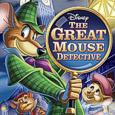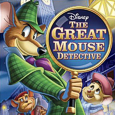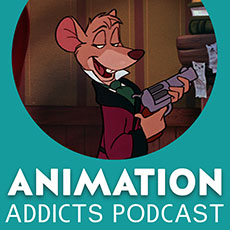Walt Disney Pictures (July 2 1986), Walt Disney Home Entertainment (October 9 2012), BD and DVD set, 74 mins plus supplement, 1080p 1.78:1 high-definition widescreen, DTS-HD 5.1 Master Audio, Rated G, Retail: $29.99
Storyboard:
When young mouse Olivia Flaversham’s toymaker father is kidnapped, it’s a case for the famous Basil of Baker Street! However, hot on criminal mastermind Professor Ratigan’s trail, Basil and his new-found friend Dr Dawson uncover a lot more than just Olivia’s missing dad when they stumble into Ratigan’s plot to take over the entire mouse population of Victorian London! Can the pint-sized Sherlock Holmes outwit his greatest enemy? Will he be able to bring a halt to the fiendish attempts to replace the Queen with an electronic robot? The chase is on, taking Basil and company from the depths of 1897 London’s sewers to a high-flying pursuit across the skies above Big Ben!
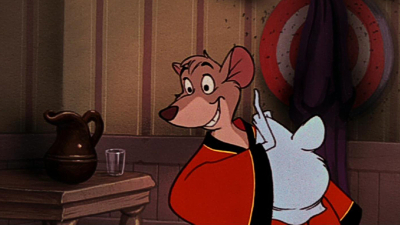
The Sweatbox Review:
The 1989 release of the Disney Studio’s The Little Mermaid and the continuous celebration of that film’s return to the grand traditions of Disney animation, leading to the Studio’s renaissance period of the 1990s, often gets a lot of deserved credit. However, this is probably attributed mostly to the fact that Mermaid was a musical fairytale in the classic style and overlooks the fact that the rebuilding of the animation department at the Mouse House actually began a couple of years earlier, with a nifty and well produced little tale that starred a mouse (mice have habitually been good for Disney!) detective. Indeed, Disney’s own industry publicity for their later CG animated film, Dinosaur, marked The Great Mouse Detective as the film that had kick-started the re-emergence of Disney animation as a commercially viable art form.
It hadn’t always been so: just a few years earlier had been a time of great change at the Studio. While the old guard were heavily involved in fulfilling Walt’s own dream of a Pooh Bear feature with the compilation The Many Adventures Of Winnie The Pooh in 1977, the next generation of artists – including Don Bluth, Glen Keane, Andreas Deja and a host of now regular names on Disney’s film credits – were taking on other projects: Pete’s Dragon, The Rescuers (then the Studio’s biggest grosser) and the film that would break from the usual formula to add a little extra edge, the dramatic The Fox And The Hound, in 1981. Disney’s Nine Old Men had peeled off into retirement over these years, and although some remained in supervisory roles, The Fox And The Hound was certainly more of a push from the new team to show what they could do.
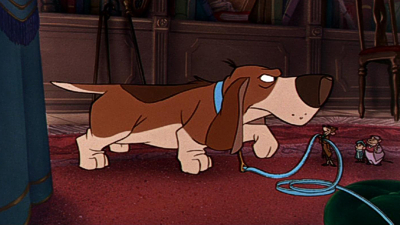
But there was still one last film to carry the thumbprints of Walt’s original artists. On and off the boil for almost ten years, The Black Cauldron was an attempt to catch the sword and sorcery trend of the late 1970s and early 1980s, not least the Disney answer to Ralph Bakshi’s interpretation of Tolkien’s The Lord Of The Rings. Coming too late by the time of release in 1985, much too dark for Disney’s usual family audiences with the Studio’s first animated PG feature rating, and sometimes incoherent due to last minute cutting by the new management team that had come in to save Disney in 1984, Cauldron broke even, and then some, at the box office and doesn’t deserve to be derided as much as its reputation suggests, but it marked a definite point when Disney animation seemed as dead as its villain’s army of skeleton corpses.
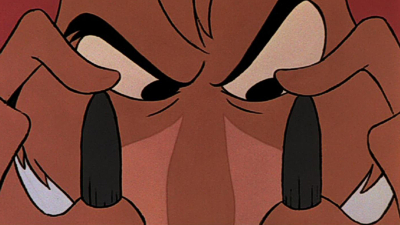
With animation on the block at the Disney Studios, the division turned – not for the last time – to a pair of young veterans: writer-directors John Musker and Ron Clements, who had learned the tricks of their trade at CalArts and who possessed an in-built feeling of what made a good Disney picture. Although their names would be joined by those of Dave Michener and Studio veteran Burny Mattinson (also director of Mickey’s Christmas Carol) on the final credits, it was Musker and Clements that had found Eve Titus and Paul Galdone’s Basil Of Baker Street children’s books, a mouse take on Conan Doyle, and who had begun to develop the concept, almost privately, during the fallout in the final dark days of The Black Cauldron. Without a follow-up project in the works, Ron ‘n’ John convinced Michael Eisner and Jeffrey Katzenberg to give the department a chance, and pitched the film as a fairly low-budget, tightly paced adventure in the classic Disney tradition.
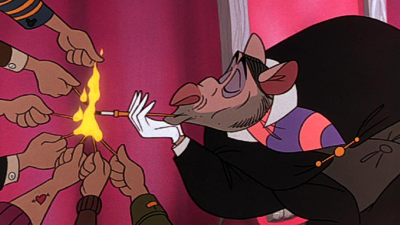
Luckily, it worked. With solid source material and a crew that was eager to put Cauldron behind them and concentrate on making a film that would stand up to the lighter fare in Disney’s past, production lasted little more than just one year, an impressive feat even more remarkable when one realizes that this was four years away from the development of the computerised CAPS process that would ink and paint Disney’s 1990s pictures. Even a title change, from Basil Of Baker Street (as if that wasn’t self-explanation enough) to the blander The Great Mouse Detective (sparking an infamous animator memo that suggested other Disney films be renamed in the same way, such as “Seven Little Men Help A Girl”) couldn’t do any harm to this great little gem of a movie (later released again as The Adventures Of The Great Mouse Detective, with international releases carrying yet another hybrid title: Basil, The Great Mouse Detective.
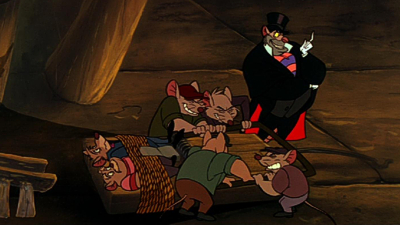
Watching the film again now, it stands up to modern day viewing, mainly because it returns to the classic Disney values of character and story, while still pushing some animation boundaries. As such, I am more than a little partial to this movie. It has great moments of the contemporary feel that would inhabit later Disney animated features, even though it is ostensibly a period picture, while losing none of the sparkle and magic that made the previous films as timeless as they are. The answer is in how the film was made: although only one year in full production, Mouse Detective spent four years in planning, and that pre-production time made sure that the artists were working with a tightly structured story, and set the blue-print for how future Disney features were made.

Re-imagined as a mousy Sherlock Holmes, Basil is every bit as clever as Conan Doyle’s mystery-story hero, but obviously skewed towards the younger reader set. The story itself follows the adventures of the super-sleuth rodent, who shares his residence with the famous (but unknowing) Sherlock Holmes himself! Recruiting a new assistant in Dr Q Dawson, Basil sets off to help find the little girl mouse Flaversham’s missing father, kidnapped by Basil’s arch nemesis, the comically twisted Professor Ratigan, who has a plan that will see him seize control of all of London! Ratigan, a hugely underrated villain in the Disney canon, has one itch – he hates being reminded that he is, in fact, literally a rat. “You’re a mouse”, one of his cronies explains. “Yeah! A big mouse!” he continues. Those who cross Ratigan are not forgiven, as he has an even bigger surprise in his army, an enormous feline mouser named Felicia, who “loves her tasty treats”!
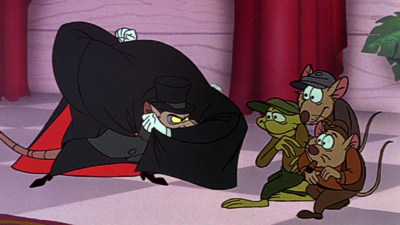
Ratigan is a tour de force of comic timing, animation and voice talent. When you’re crossing Glen Keane (the huge, bulky rounded shoulders he loves to draw are the giveaway) with the vocals of none other than Vincent Price, where can you go wrong? Price offers a full and rich reading of his lines and was very proud of his work in the film, as he had been written two songs to sing – a new experience for him. The World’s Greatest Criminal Mind, one of just three songs in the film co-written (as is the score) by Henry Mancini, is an instant classic, and one of the best “these-are-my-dastardly-deeds-and-now-I’m-going-one-better” villain’s songs. The rest of the score is very magical and a direct cue from the John Williams fantasy sound, while the smattering of songs do not intrude on the story and are often used as source music for a backdrop to a scene.

Other voices in the film will also be familiar to Disney fans: Dr Dawson is voiced by Val Bettin, who would go on to voice the Sultan in the later television and video spin-offs from 1992’s Aladdin, and Flaversham himself by Disney favorite Alan Young, who had done a sterling job as Scrooge in Mickey’s Christmas Carol and would continue the role in the Duck Tales television adventures. Another famous voice, that of Basil Rathbone, was lifted from an earlier live-action Sherlock film for a couple of lines of Holmes’ dialogue, though Rathbone himself had also featured in a Disney film, narrating the Mr Toad segment in The Adventures Of Ichabod And Mr Toad (1949). The characters are wonderful, with Basil himself just the right mixture of charm and arrogance, and rest of the supporting cast are all memorable, not least Ratigan’s perfectly named hench-bat Fidget!
This is a hybrid Disney feature in more ways than one. Apart from the slight change in musical styles (it’s not a full-blown musical) the animation here is totally handled by the new group of animators (among the supervising directors are Keane, Musker and Clements, as well as Mark Henn, Rob Minkoff, Hendel Butoy and Phil Nibbelink), who were led by just one of Walt’s original Old Men, Eric Larson. Nibbelink also helped deliver The Great Mouse Detective’s masterstroke – a daring fight held deep in the cogs of the Big Ben clock: this was the first time computer animation had been combined with full-quality drawn character animation, and much was made at the time in the press that computers were edging traditional artists out.
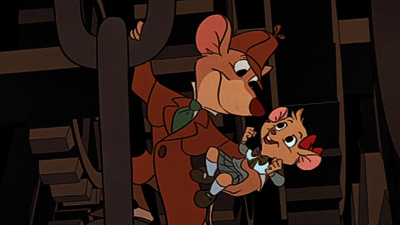
Nothing could have been further than the truth, of course. Although nowadays computer imagery can be printed optically direct to film, back in 1986, each frame of Big Ben’s interior structure was printed out and hand colored on cels, much as a standard character would be. Perhaps it’s because this process had to be carried out in this way that the integration of character and computer animation is so engaging and enthralling. Music, editing, pacing and direction make this sequence a classic in modern animation and it should not be overlooked as much as it has been. The rest of the film sparkles too, with some good character moments even if they haven’t found themselves resting with the best of Disney, something that I’ve never quite understood, given the healthy box office reaction to the film and decent performance opposite Bluth/Spielberg’s An American Tail in the same year.

Traditionally, The Great Mouse Detective provides a lovely little return to what Disney does best, and it remains a lean film with a forward momentum of its own. Historically, more kudos than it is usually attributed should be awarded to the project for bringing the Studio’s artists back to their roots and to a place creatively where they were actually able to pull off their later milestones. As a result of the film’s story strength, Katzenberg was eager to progress with his own pick, the pop-scored musical take on Charles Dickens, Oliver & Company, and Musker and Clements’ next endeavor, The Little Mermaid, the film that would draw even more on classic Disney and set the directing pair on the road to Aladdin, Hercules and the recent return to the Studio’s hand-drawn animation, The Princess And The Frog.
Right here is where that new wave of memorable Disney animated entertainment began: always mindful of the past but eager to push ahead to the future. With some of the “old school” feel Disney in attendance, and much of the new breed out to impress, it’s Basil to the rescue, in what the packaging quite rightly and cannily calls “Disney’s greatest little mystery in history”!
Is This Thing Loaded?
Released to theaters again in 1992, The Great Mouse Detective had an unusually long home video wait before debuting on VHS and LaserDisc, eventually coming to DVD ten years later, in 2002, as a quasi-Special Edition disc that wasn’t part of Disney’s then Gold Collection line and wasn’t a full-blown deluxe set either. There wasn’t an abundant amount of material to get stuck into, but at least it wasn’t totally devoid of any extra fun and, in short, provided a heck of a lot more material than the meagre offerings compiled here in this Blu-ray repeat of the last DVD’s “Mystery In The Mist Edition”, which drops many of the original DVD’s supplements and adds nothing new to the mix.
So You Think You Can Sleuth? (4:40) is a hybrid featurette-game combo that isn’t much of one thing or the other. Starting off with a look at the need for detectives over human history (though the fast and snappy pace means specific info is thrown around so fast that little of it sticks, using random archive clips to illustrate), the featurette becomes more of a game – as hinted at by the narrator – around the three minute mark. Only, this isn’t a “game” at all, being a video collection of voiceover and photo stills that seem to promise the chance to try your hand at solving a light-hearted crime. However, when this “intro” is completed, and you might be expecting a switch to an interactive screen to start naming suspects, the culprit is revealed straight off and the disc reverts to its static menu! The first half offers some basic info, but apart from that there’s really not much to do here.

Thankfully an archival featurette from 1986, The Making Of The Great Mouse Detective, has been retained: running almost eight minutes, you’ll find all the cast and crew gushing about making the film from the time of the film’s release, from a nice bunch of soundbites with the voices and musical crew, to a little info on the computer graphics. Even if the electronic press kit feel isn’t as in-depth as collectors would like, this is a welcome archival piece and actually a pretty good overview of the production if way too brief, though my favorite moments are when co-songwriter Melissa Manchester appears to talk about her club-singer mouse song Let Me Be Good To You (an inspiration for Jessica Rabbit?): just look at those togs – stuck in an ’80s fashion time-warp or what!?
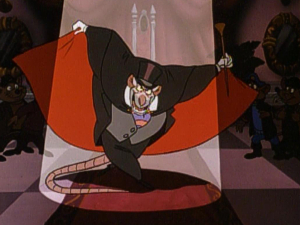
However, while this was a welcome addition on the old disc, it seems a little more lazy here when Disney’s recent batch of BD upgrades have all included a token new extra in HD to entice fans old and new. It would have been very nice to have seen how the artists feel about the film looking back on it now or even have a new audio commentary with the still Disney-based directors, but it just doesn’t seem the Studio is that keen to bring anything new to the title. This is perfectly illustrated by also pulling over Vincent Price’s classic song moment from the previous releases for The World’s Greatest Criminal Mind Sing-along. Presented in full-frame 4×3, this heavily truncated version of the song offers a chance to see what the film looked like pre-restoration and in pan-and-scan format – ugly!
And…that’s all folks!

Missing from the initial 2002 DVD are a couple of superfluous extras – the golden age animated shorts Clock Cleaners (for its tenuous link to the Big Ben scenes in the main feature) and Donald’s Crime (which has a couple of similarities with the feature’s artwork), though a better short would have been Goofy’s How To Be A Detective from 1952 – or simply how about any of these in HD!? An even bigger disappointment from the first DVD is the pointless removal of The Great Mouse Detective Scrapbook, which highlighted selected concept and production art from Visual Development, Character Designs and Storyboards, to Behind The Scenes and Publicity – all missing again here. Perhaps this is another mystery for Basil to take on as his next case?
The included DVD (an almost exact duplicate of the previous Mist disc) includes all three extras, if that’s any incitement, and the only other material of note is the usual collection of Sneak Peeks: Cinderella and the Cinderella II & III 2-Movie Collection, Finding Nemo, Beverly Hills Chihuahua 3, Secret Of The Wings and Planes are among the spots included. Naturally, we wouldn’t expect the Studio to bolster the slim pickings by including the original theatrical trailer for The Great Mouse Detective, would we? Good, because that’s not here either!
Case Study:
As with the previous “Mystery In The Mist” DVD (so named for…well, who knows why!?), at least there’s one plus point when it comes to the artwork: once again the half-decent cover art, while not matching the original theatrical poster for adventurous intrigue, is better than what came before for VHS and LaserDisc releases, and especially the appallingly poor 2002 sleeve, which was badly drawn and off model. The cover art is largely the same, albeit now given the Disney BD treatment to feature a blue border, although I still don’t get why Basil wears a green deerstalker jacket since he wears brown in the film (and poor Olivia is still off model too).
As with the previous DVD, the designers haven’t been bothered to resize the title treatment on the spine of the shiny (but non-embossed) slipcase or sleeve, leading to each successive word of the title to get smaller even though the space is there to realign them (the result being that “Detective” is smaller than “Great” by half). Inside, there’s basically nothing except for a standard Movie Reward code insert, while the discs’ art is just as boring: just a standard blue for the BD and the same grey print as before for the DVD. Maybe this is supposed to be the “mist” in the Mystery In The Mist edition?
Ink And Paint:
Undergoing a number of name changes in theatrical release, the resulting movie finally reached DVD in its original incarnation of The Great Mouse Detective, although the print used was sourced from the 1992 The Adventures Of The Great Mouse Detective. Here the title on the actual print has the film credited correctly under its original, simpler moniker, which standardizes things across the board. Title changes aside, this Blu-ray update doesn’t indicate any kind of new digital restoration but it clearly uses the remastered transfer that appeared on the previous Mystery In The Mist DVD – meaning a repeat of the 1.78:1 ratio from that edition. Checking against the 2002 DVD, the odd thing here, apart from a more saturated color palette that can be quite intense, is that Disney has been playing with their aspect ratios again.
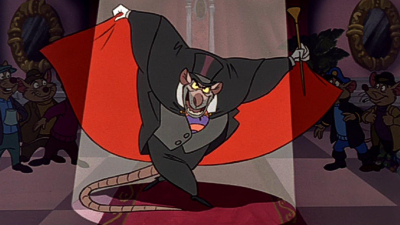
Released in 2002 in the “original theatrical ratio” of 1.66:1, the image here is a slightly wider 1.78, with basically the blanking plates on the sides of the 1.66 image removed to show more picture information left and right. Even so, this “new” framing still has the irritating feeling that some shots are a little cramped, and I wonder if this is still essentially a 1.66 image zoomed in to 1.78, cropping a little top and bottom to fill the frame, since there are certainly shots where characters’ heads are trimmed a little too much. As a comparison, the differences between this 1.78 framing and the 1.33 “open matte” ratio as seen in the World’s Greatest Criminal Mind sing-along (check the screenshots in this review) make it clear that some image info is still missing here.
However, the transfer itself is certainly an improvement on before even if The Great Mouse Detective hasn’t been given a total digital clean as per Snow White or even The AristoCats. Here it falls more in line with the second-grade images of The Fox And The Hound and the restored shorts that Disney have previously released, meaning that although the image is stable, grain is clearly evident and some may spot slight print fluctuations: remember that this was a very low-budget production for the time and some artifacts, such as cel scuffs, are historically present in the film itself. On the plus side, the Big Ben CG shots now integrate better with the rest of the film and, while it perhaps isn’t as spotless as the latest digital conversions, the images are fairly clean and faithful to how audiences would have seen them in 1986.
Scratch Tracks:
Given a new 5.1 surround mix for its 1992 theatrical reissue, this track was carried over to the 2002 and Mystery In The Mist DVD releases and sounds (without going to any great lengths to compare waveforms!) like the exact same mix used again here. It’s a very spacious track: the original masters would have been created in 1986, when Dolby was still relatively new and sound designers were all having loads of fun placing their effects, spreading their surrounds and pushing the dynamics, so the 1992 re-recording had a lot of play to start with.
If it sounds a hint more active this time around, put it down to the lack of compression: the DTS-MA track opens things up and one can tell the difference between the DVDs and this new BD immediately on hearing Mancini’s opening theme. The music score is often pushed to the fore and sounds great, and where I thought the dialogue sat too low in the DVD mix here it almost sounds too loud in places! French and Spanish subtitles and language tracks in Dolby 5.1 are optional, and they are all exceptional, with many of the voices spot on versions of their characters.
Final Cut:
Those fans of The Great Mouse Detective that have waited patiently for a definitive release of their favorite film and witnessed poor attempts previously on DVD will again be disappointed with the Mystery In The Mist’s Blu-ray edition, which does nothing new but offer the main feature in HD. After Disney’s surprisingly strong BD updates earlier this summer, one could even use the word “lackluster” to describe it, the only mystery being why they thought to put this essentially barebones disc out at all. The movie itself looks improved, but not to the extent that The Rescuers or The AristoCats did, and there are still questions to be had about the correct aspect ratio.
But The Great Mouse Detective still deserves a spot on collectors’ shelves: we’re not likely to get anything better and historically this is the project – and a hugely entertaining one at that – where a new generation of artists found their solid ground, introducing the initial methods of combining three-dimensional computer generated backdrops with hand-drawn character animation that led to the techniques that would showcase themselves in Who Framed Roger Rabbit and allow the artists to flourish over the next decade.
As a Blu-ray experience it quite frankly stinks – the omission of the original trailer is a real shame, as are any audio or video recollections from Musker, Clements or producer Mattinson. With a total lack of any substantial extras, it’s the movie fans will be shelling out for and Disney seems to know this, as evidenced by the $30 list price (and more than $10 less online). Do some detective work and hunt it down for something more reasonable – the disc can’t be recommended for its overall package but the movie itself is more than a minor classic, even if Disney doesn’t think so.
 | ||
 |



